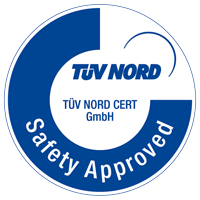Description
The vibrating limit switch is a level limit switch for all kinds of fluids and is used in tanks, containers and pipelines.
Technical Data
Properties
- Protection class EN60529
- IP 65/IP 67
- Operating pressure
- ≤ 40 bar
- media density
- ρ ≥ 0,7 g/cm³
- Viscosity
- max. 10000 mm²s
- Rated current
- < 15 mA
- Protection class
- III
- Output
- PNP
- power
- kurzschlussfest, überlastsicher
- Display
- LED (grün, rot)
- Switching delay (cover)
- ca. 0,5 s
- Switching delay (release)
- ca. 1 s
NSP-1-E
- connection thread
- G 1”
- Operating temperature
- –40...+150 °C
- Storage temperature
- –40...+85 °C
- nominal voltage
- 10...55 V DC (verpolsicher)
- Current output
- ≤ 350 mA
NSP-2-E
- connection thread
- G ½”
- Operating temperature
- –40...+100 °C
- Storage temperature
- –20...+70 °C
- nominal voltage
- 10...35 V DC (verpolsicher)
- Current output
- ≤ 250 mA
NSP-X-E application-specific configuration
NSP - [ 1 ] - [ 2 ]
Further product information
It is used in cleaning and filtering systems and coolant and
lubricant tanks as an overspill protection or as a pump protector.
It also works in applications which are unsuitable for other measuring methods due to conductivity, build-ups, turbulence, flows or air bubbles.
The NSP-1-E/NSP-2-E can be installed in any position in a tank or pipe. The formation of foam does not impair its function.
The NSP-1-E/NSP-2-E is suitable for any liquid which drips from the fork of the NSP-1-E/NSP-2-E so that the fork can oscillate freely. The liquid may also contain solids which are smaller than 5 mm.
The vibration fork is actuated piezoelectrically. It is vibrating with its resonance frequency in air.
Liquids getting into contact with the fork are changing this frequency. This change is evaluated electronically and produces the switching signal.
- Vibration limit switch for liquids
- Fork & Housing: Stainless steel
Functional test
Performed with test magnet (accessories) on mounted device. Sequential circuits can be tested (like PLCs or control systems) without demounting the device and without media contact.














